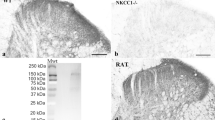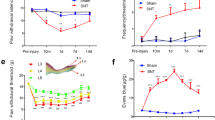Abstract
In addition to their actions at supraspinal sites, opiates can act directly at the spinal cord level to produce analgesia1–3. Opiate receptors and enkephalins are found in abundance in the dorsal horn of the spinal cord, in the region of termination of small-diameter primary afferents4–6. Furthermore, there is evidence that exogenously administered opiates or endogenous enkephalins act both on postsynaptic receptors in dorsal horn and presynaptically to block transmitter release from nociceptive primary afferent terminals7–10. The possiblity of these two distinct sites of opiate action in dorsal horn is of particular interest in view of recent evidence for the existence of multiple opiate receptors11–13. On the basis of differences in the rank orders of potency of opiate alkaloids and opoid peptides observed in different tissues, Lord et al.14 have proposed two categories of opiate receptor, μ and δ, and these can be differentiated in binding studies, provided that selective radioglands are used in the appropriate experimental conditions15–18. Here we have used the selective radioligands 3H-morphine (μ sites) and 3H-D-Ala2, D-Leu5-enkephalin (δ sites) to examine directly in rat the distribution and binding characteristics of opiate receptors on dorsal root and in various regions of the adjacent spinal cord. Primary afferent tissue (dorsal root) and dorsal horn were found to contain μ and δ opiate binding sites with a relatively high proportion of μ sites. Partial destruction of small-diameter primary afferents after cutting the sciatic nerve led to a significant reduction in both μ and δ binding sites on dorsal roots, suggesting that both types of opiate receptors may exist on small-diameter primary afferents.
This is a preview of subscription content, access via your institution
Access options
Subscribe to this journal
Receive 51 print issues and online access
$199.00 per year
only $3.90 per issue
Buy this article
- Purchase on Springer Link
- Instant access to full article PDF
Prices may be subject to local taxes which are calculated during checkout
Similar content being viewed by others
References
Yaksh, T. L. & Rudy, J. A. J. Pharmac. exp. Ther. 202, 411–428 (1977).
Yaskh, T. L. Brain Res. 153, 205–210 (1978).
Wang, J. K., Nauss, L. A. & Thomas, J. E. Anaesthesiology 50, 149–151 (1979).
Hökfelt, T., Ljungdahl, A., Terenius, L., Elde, R. & Nilsson, G. Proc. natn. Acad. Sci. U.S.A. 74, 3081–3085 (1977).
Pert, C. B., Kuhar, M. J. & Snyder, S. H. Life Sci. 16, 1849–1854 (1975).
Atweh, S. F. & Kuhar, M. J. Brain Res. 124, 53–67 (1977).
Jessell, T. M. & Iversen, L. L. Nature 268, 549–551 (1977).
Mudge, A. W., Leeman, S. E. & Fischbach, G. D. Proc. natn. Acad. Sci. U.S.A. 76, 526–530 (1979).
Duggan, A. W., Hall, J. G. & Headley, P. M. Br. J. Pharmac. 61, 67–76 (1977).
Le Bars, D., Guilbaud, G., Jurna, I. & Besson, J. M. Brain Res. 98, 261–277 (1976).
Martin, W. R., Eades, C. G., Thompson, J. A., Huppler, R. E. & Gilbert, P. E. J. Pharmac. exp. Ther. 197, 517–532 (1976).
Terenius, L. Psychoneuroendocrinology 2, 53–58 (1977).
Waterfield, A. A., Smockum, R. W. J., Hughes, J., Kosterlitz, H. W. & Kosterlitz, H. W. & Henderson, G. Eur. J. Pharmac. 43, 107–116 (1977).
Lord, J. A. H., Waterfield, A. A., Hughes, J. & Kosterlitz, H. W. Nature 267, 495–500 (1977).
Robson, L. E. & Kosterlitz, H. W. Proc. R. Soc. B205, 425–432 (1979).
Terenius, L. & Wahlström, A. Eur. J. Pharmac. 40, 241–248 (1976).
Chang, K-J., Cooper, B. R., Hazum, E. & Cuatrecasas, P. Molec. Pharmac. 16, 91–104 (1979).
Chang, K-J. & Cuatrecasas, P. J. biol. Chem. 254, 2610–2618 (1979).
Ranson, S. W. J. comp. Neurol. 16, 265–293 (1906).
Aldskogius, H. & Arvidsson, J. J. Neurocytol. 7, 229–250 (1978).
Knyihár, E. & Csillik, B. Expl Brain Res. 26, 73–87 (1976).
Jessell, T., Tsunoo, A., Kanazawa, I. & Otsuka, M. Brain Res. 168, 247–259 (1979).
LaMotte, C., Pert, C. B. & Snyder, S. H. Brain Res. 112, 407–412 (1976).
Atweh, S. F., Murrin, L. C. & Kuhar, M. J. Neuropharmacology 17, 65–71 (1978).
Jancso, G., Kiraly, E. & Jancso-Gabor, A. Nature 270, 741–743 (1977).
Gamse, R., Holzer, P. & Lembeck, F. Naunyn-Schmiedebergs Archs Pharmak. 308, 281–285 (1979).
Nagy, J. I. et al. Brain Res. (in the press).
Carstens, E., Tulloch, I., Zieglgansberger, W. & Zimmermann, M. Pflügers Arch. ges. Physiol. 379, 143–147 (1979).
Sastry, B. R. Neuropharmacology 18, 367–375 (1979).
Author information
Authors and Affiliations
Rights and permissions
About this article
Cite this article
Fields, H., Emson, P., Leigh, B. et al. Multiple opiate receptor sites on primary afferent fibres. Nature 284, 351–353 (1980). https://doi.org/10.1038/284351a0
Received:
Accepted:
Issue Date:
DOI: https://doi.org/10.1038/284351a0
This article is cited by
-
Narcotic analgesics
Inflammopharmacology (2024)
-
A study to compare the efficacy of intrathecal dexmedetomidine versus nalbuphine as an adjuvant to 0.5% hyperbaric bupivacaine for postoperative analgesia in lower abdominal surgeries
Ain-Shams Journal of Anesthesiology (2022)
-
Role of opioid receptors in modulation of P2X receptor-mediated cardiac sympathoexcitatory reflex response
Scientific Reports (2019)
-
Hintergrund und aktueller Einsatz von Adjuvanzien für die Regionalanästhesie
Der Anaesthesist (2019)
Comments
By submitting a comment you agree to abide by our Terms and Community Guidelines. If you find something abusive or that does not comply with our terms or guidelines please flag it as inappropriate.



